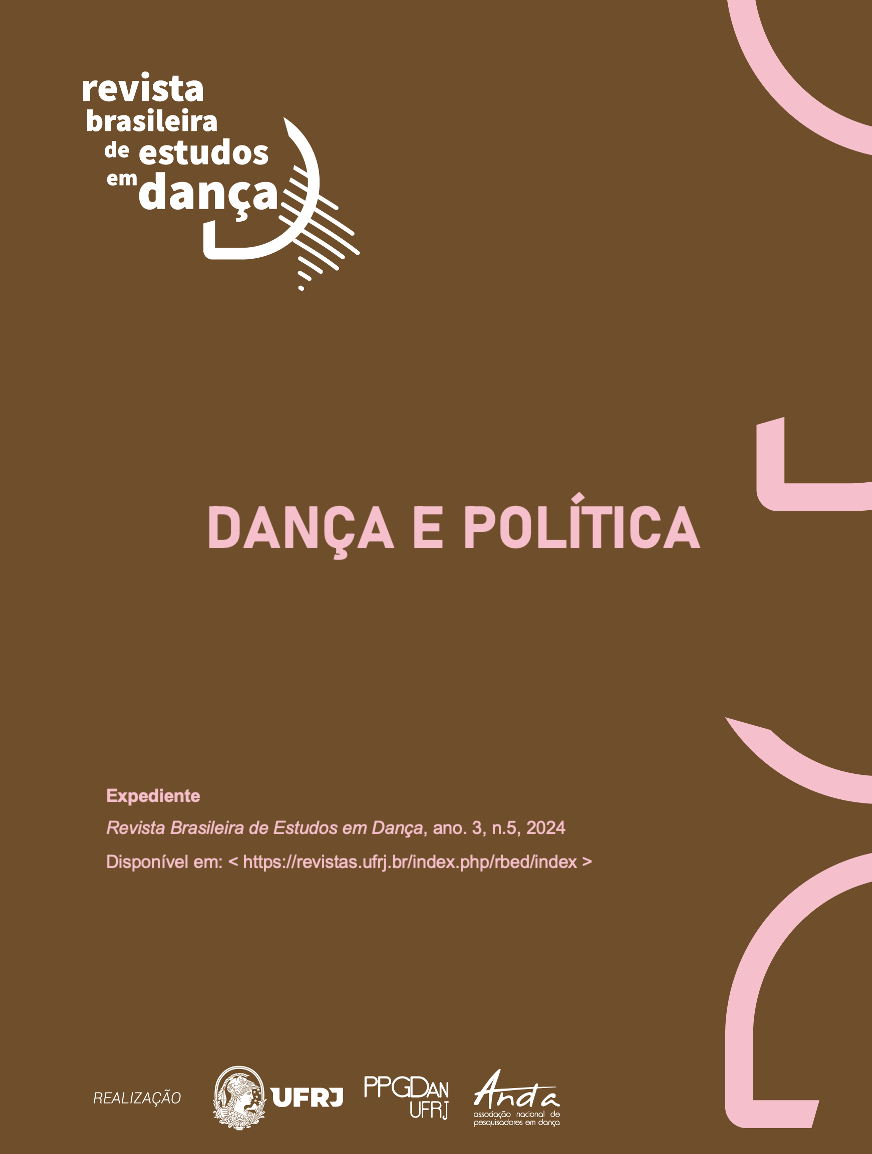Shared kinespheres: from individual to collective space
DOI:
https://doi.org/10.58786/rbed.2024.v3.n5.63102Abstract
This paper reflects and conceptualises the notion of shared kinesphere, which has been elaborated by the author in her Laban Movement Analysis experiments in dance activities since 2013. It approaches the concept of kinesphere from Labanian Choreutics, as well as presents and discusses its developments from scholars and artists such as Monica Allende Serra, Ciane Fernandes and William Forsythe, who specified singular ways of using the concept in their artistic and pedagogical investigations. Then, it discusses and reflects on the sharing of a common sphere of movement between two or more people, addressing implications that the image and sensation of the shared kinesphere can have on the quality of improvisational encounters and on the creation of other dynamics and spatial tensions for duos, trios or groups that dance together.
Downloads
References
BARBOSA, V.V.P. Entre o cultivo e a espera: caminhos para uma poética de permanência e transformação na dança. 2019. 233 p. Tese (Doutorado em Artes Cênicas) – Escola de Teatro, Universidade Federal da Bahia (UFBA), 2019.
CALDAS, Paulo. Linhas Serpentinas: Notas sobre uma abordagem labaniana do espaço. Revista Cena, Porto Alegre, nº 32 p. 58-72 set./dez. 2020 Disponível em: http://seer.ufrgs.br/cena
EARP, Ana Célia de Sá. Princípios de conexões dos movimentos básicos em suas relações anátomo-cinesiológicas na dança segundo Helenita Sá Earp. In: VI Congresso de Pesquisa e Pós - Graduação em Artes Cênicas. 2010, São Paulo. V Congresso da Abrace. São Paulo: ABRACE, 2010. v. 1. p. 1-7.
GUEST, Ann Hutchinson. Labanotation: the system of analyzing and recording movement. Fourth Edition. Illustrated by Doug Anderson. New York: Routledge, 2005.
LABAN, Rudolf. Choreutics. Annotated and edited by Lisa Ullman. Hampshire, UK: Dance
Books, 2011a.
LABAN, Rudolf. The Mastery of Movement. Fourth Edition. Revised by Lisa Ullman. Hampshire, UK: Dance Books, 2011b.
LABAN, Rudolf. A vision of dynamic space. London and Philadelphia: The Falmer Press, 1984.
LABAN, Rudolf. Modern Educational Dance. Third Edition. Revised with additions by Lisa
Ullman. London, MacDonald & Evans, 1975.
LABAN, Rudolf. Rudolph Laban’s unpublished article. Guildford: University of Surrey Library, Laban Archive, L/E/5/15, s.d.
LAUNAY, Isabelle. A la recherche d’une danse moderne: Rudolf Laban et Mary Wigman. Université de Paris 8, Saint-Denis - Département Danse, 1997.
LAUNAY, Isabelle. Laban, ou a experiência da dança. Trad. Gustavo Ciríaco. In: PEREIRA, Roberto & SOTER, Silvia (orgs). Lições de Dança I. Rio de Janeiro: Univercidade Editora, 1999.
MCCAW, Dick (org.). The Laban Sourcebook. London and New York: Routledge, 2011.
MERLEAU-PONTY, Maurice (1908-1961). Fenomenologia da Percepção. São Paulo: Martins Fontes, 2006.
MOTTA, Maria Alice Monteiro. Teoria Fundamentos da Dança: uma abordagem epistemológica à luz da Teoria das Estranhezas. (Dissertação) Mestrado em Ciência da Arte. Niterói: Universidade Federal Fluminense, 2006.
RENGEL, Lenira P. Dicionário Laban. São Paulo: Annablume, 2003.
Downloads
Published
How to Cite
Issue
Section
License
Authors who publish in the Revista Brasileira de Estudos em Dança are
responsible for the content of signed articles and retain copyright.
They grant the journal the right of first publication with the work simultaneously
licensed under the Creative Commons Attribution-NonCommercial 4.0 License
(Open Archives Initiative - OAI). This feature, used for open-access journals,
allows sharing work for non-commercial purposes and acknowledges
authorship. If the text is later published in another vehicle, the author
must inform that it was initially published as an article in the Revista Brasileira
de Estudos em Dança. Therefore, even if the journal owns the first publication,
authors are entitled to publish their work in institutional repositories or on
their personal pages, even if the editorial process has not been completed.
The journal reserves the right to make normative, orthographic, and grammatical changes to maintain the language standard, respecting the authorial style.

